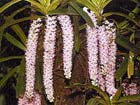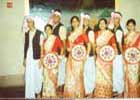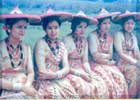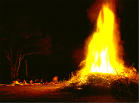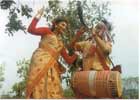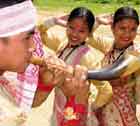There are three Bihu’s. In April it is Bohag Bihu , in October/November it is Kati Bihu and in January it is Magh Bihu. The Bihus mark three distinct phases of the farming calendar for the native crop of Assam i.e. paddy.
The Bohaag Bihu ushers in the period of greatest enjoyment and the spring season. Gay spirit of spring marks the celebration of Bohaag Bihu, which continues for three days. It marks the New Year at the advent of seeding time, the "Kaati Bihu" marks the completion of sowing and transplanting of paddies, and the "Maagh Bihu marks the end of the harvesting period. Bohaag Bihu is also called the "Rangali Bihu" or the Festival of Merriment, Magh Bihu is also called "Bhogali Bihu" or the Festival of Food, and Kaati Bihu is also called "Kongaali Bihu" or the Festival of the Poor. Rongali or Bohag Bihu, celebrated is the most important.
Bhogali Bihu / Magh Bihu
Magh Bihu is also known as Bhogali Bihu, derived from the word Bhoga
meaning eating or enjoyment. This festival is called as the Magh Bihu
and is celebrated usually on the 14th and 15th of January in the month
of Magh. This festival denotes the end of the winter paddy harvest.
The celebrations start a day before the festival actually begins.
The earlier night, the religious Assamese fast and pray. Women get
busy preparing rice cakes and other refreshments.The first day is called Uruka. The most significant part of this Uruka day is the building of 'Meji' and feasting at night. The Meji is a very high temple like structure of firewood, piled up, one piece over the other held together by bamboo poles from the four corners, which is built outside the house. A makeshift cottage called Bhelaghar is built nearby the Meji. The whole night is spent in feasting, merry - making dancing and singing.
The very next dawn witnesses the commencement of the festival.At the break of dawn, on the first day of Magh, people take their bath early.
To denote that the festival has begun, the Mejis and Bhelaghars are set on fire. people sit and sing "Naam-Kirtana'.Offerings of 'Til' (Sesame seeds), rice and other eatables are made to 'Agni' or God of fire. The ashes of the burnt meji is scattered over the fields, for it is believed that doing so would increase the fertility of the soil.
The mid - day lunch on this day is not rice and curry but 'Chira' (flattened rice), 'Pitha' (rice - cakes) curd and so on. One special preparation is 'Wah-Karai', a combination of roasted rice, black gram, sesame and pieces of ginger, which when offered for chewing is smeared with oil. No meat is allowed on this day. The whole day is celebrated in a pompous manner with bullfights attracting huge crowds. Bihu is celebrated the rest of the day with dance and music.
The Bihu dance is a distinct one and is a special attraction as young boys and girls mainly perform it.
All the people celebrate the festival in an equally joyous mood. They tend to forget their caste, creed, religion and even superstitious faiths and beliefs.
Tribal groups like the Mishings, the Deoris, and the Morans celebrate "Bihu" with dances of their own distinctive style.
According to another explanation - the three Bihu festivals represent
the three phases of human life: birth, growth and death. While Bhogali Bihu
represents the birth and nurturing in the form of the harvest, Rongali
Bihu represents its growth and adult hood. Kati Bihu represents the
symbolic death when the fields are bare. But even in death lies the
hope of birth.
See also Bhugali Bihu (April) and Kati Bihu (October).



